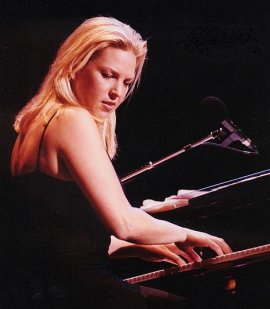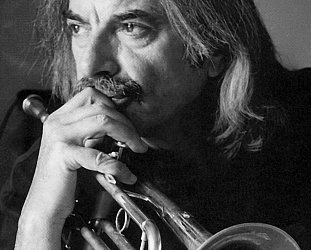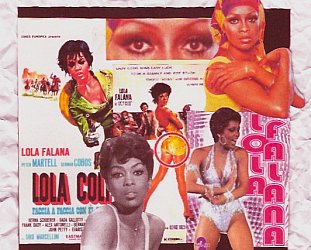Graham Reid | | 5 min read
Joe Henderson: Miles Ahead (with John Scofield, Dave Holland and Al Foster, from the 1993 Verve albu

Sometimes, if we are lucky we can be at
historic events. But we might not realise it until later. If a
historic event is the Foo Fighters first recording as a band -- and
remember Dave Grohl did the band's debut album himself -- then I can
immodestly claim to have been there.
It was in a BBC studio in London, Pat
Smear lit one after another beneath the No Smoking sign, while Grohl
was witty and likable. And I didn’t know it was “historic”
until I interviewed him months later and he told me that was the
first time a band called the Foo Fighters had ever recorded together.
A “historic” event I didn't -- but
also couldn't -- recognise until later was at Carnegie Hall in April
1994, when the Verve jazz label threw a party for itself. It was
ostensibly to celebrate Verve’s 50th birthday -- it wasn't, but
more of that later -- and included an encyclopedia of jazz giants
including Joe Henderson, Charlie Haden, Jackie McLean, Betty Carter
and many others.
I recall little of who played what,
although I remember the Beatles 1964 lobby poster, the wired and
witty bum outside hustling small change from the glitterati, and
plunging necklines down beautiful New York breasts.
But one performance has my heart
shivering even now: that by bossa nova genius, Antonio Carlos Jobim,
who wrote -- among many things -- The Girl From Ipanema.
He only played two songs: one a lovely
treatment of his How Insensitive with guitarist Pat Metheny; the
other a bitter-sweet Ipanema.
When he wrote Ipanema, he was a younger
man, but at Carnegie Hall as he bent over the piano and whispered the
lyrics it took on a different meaning. Now he was old: “Each day
when she walks to the sea, she looks straight ahead not at he”,
means something else when you know beautiful women are unattainable
and will never again look at you. Ever.
It was an exceptional reading of a song
that has become a shallow cocktail lounge anthem. Unfortunately it's
not on the Carnegie Hall Salutes the Jazz Masters album recorded on
the night. But it was a historic moment -- although no one knew it
then.
It would be Jobim’s last live
performance.
On the night Jobim was only one genius
among many. What a 50th birthday for Verve in '94. Well, actually no.
Verve was founded by Norman Grantz in
1956, but “38th anniversary” doesn't have quite the same cachet,
does it?
The tuxedo-conceit actually celebrated
50 years since Grantz's famous, racially-integrated 1944 benefit
concert in LA – yes, another coast and an American world away --
that took club jazz onto the concert stage.
Some of the label's newer signings on
that '94 night, such as Japanese pianist Yosuke Yamashita, hadn’t
earned their place in the jazz pantheon, but the night was more than
a showcase of the past while introducing Verve's fresh signings. It
was about re-launching the label, which had lost its direction after
Grantz – who wouldn’t attend the “anniversary” -- sold it in
1960. In that regard it was a success.
Since then Joe Henderson underwent a
much deserved rediscovery, and newer names such Diana Krall, Dee Dee
Bridgewater and violinist Regina Carter have more than paid the
company’s photocopy bill. And Verve's back-catalogue has been
represented to much acclaim.
As Pete Watrous observed in the New
York Times; if you took out Verve albums such as Ella Fitzgerald’s
interpretations of American standards, Stan Getz bossa-nova albums
(some with Jobim) and their catalogue of Billie Holiday and Charlie
Parker, the 20th century would sound very different.
The question now is, will the first
half of the 21st century sound different with Verve?
And that's leaving aside the more
difficult question of whether jazz is even relevant in this new
non-jazz millennium.
 Well, Verve certainly had creditable
newer signings; guitarist John Scofield, Natalie Cole, Grammy-grabber
Krall (left) and others.
Well, Verve certainly had creditable
newer signings; guitarist John Scofield, Natalie Cole, Grammy-grabber
Krall (left) and others.
Then there are the venerables: bassist/composer
Charlie Haden – a one-time Ornette Coleman alumni who won a Grammy
for Best Latin Jazz Album for Nocturne; Wayne Shorter; Herbie
Hancock; trumpeter Roy Hargrove; and the ever-popular Michael Brecker
who, whatever you make of his populist approach, just keeps on
picking up Grammys (at least eight).
And of course there's that Verve
back-catalogue any serious jazz listener -- even in 50 more years --
will discover as of historic significance.
But, as Blue Note learned when it
allowed US3 to raid its vaults, it helps to be hip.
Verve spotted an opening there too.
In 2002 it released Sounds From the
Verve Hi-Fi which was a quietly persuasive selection of rare jewels
and Verve classics complied by Thievery Corporation for the chill-out
room or pre-coital mood. It featured languid jazz-samba and bossa
moods, some kitschy period pieces (with electric sitar) by Sergio
Mendes and Brazil 66, the sensual sound of Wes Montgomery’s guitar
and organist Jimmy Smith, and many more.
Yep. It was very cool, however you
might define that word.
And there was also Astrud Gilberto --
who originally sang Jobim's Ipanema -- on an afterhours version of
the Doors’ Light My Fire.
My guess is such things will await
discovery by new generations, whether they’re interested jazz or
just mood music.
Verve also keeping apace with the
present tense via the Verve Remixed album, which featured Nina
Simone, Dinah Washington, Ella, Billie and others remixed by the
likes of Tricky (courageously taking on Holiday’s Strange Fruit),
Richard Dortmeister, Masters At Work, Rae & Christian, Thievery
Corp and others.
And sometime Auckland
pianist/composer/remixer, Mark de Clive-Lowe, re-presenting Shirley
Horn's Return to Paradise. A thought occurs; De Clive-Lowe had
possibly written himself into history, but he might not realise it
until later.
These days Verve – like Blue Note –
has a lot of non-jazz signings like Teddy Thompson and drummer Brian
Blade (who plays jazz but also does alt.country).
Norman Grantz, who died in 2001, might
have been astonished to learn that on the Verve Forecast imprint –
a brand which suggests looking ahead – is now that hip young jazz
cat . . . Jerry Lee Lewis.







post a comment